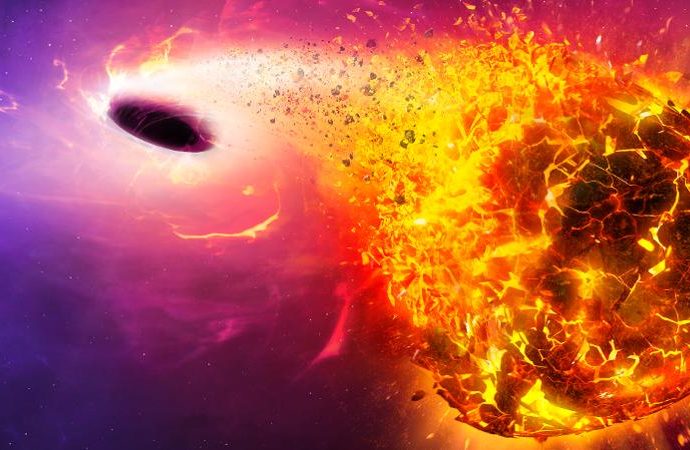Generally speaking, black holes are the corpse of a dead star. But not all stars become black holes at the end of their life – for instance, our familiar Sun is small enough to avoid that fate.
Source: Forbes
Until recently, black holes were thought to be formed only by super-massive stars, and the smallest black hole known to scientists was about five times the mass of the Sun. However, a recent scientific paper has announced the discovery of a black hole much smaller than that. This would require astronomers to rethink their models of black hole formation, because black holes shouldn’t be so small.
So, what sets the mass of a black hole? It’s the size of the star from which it was formed. Black holes come from big stars and, like some of their Hollywood kin, big stars live fast and die young. A high mass burns through their fuel very quickly, first converting hydrogen to helium, and then, when the hydrogen runs out, heating up and burning helium. During the helium-burning phase, the core of the star puffs up and it becomes red giant, with a radius large enough to encompass the orbit of the Earth.

Eventually, the helium runs out too, and even heavier elements are used to power the nuclear fusion of the star, with oxygen, then silicon, until finally the star is converting its material into iron. And when iron appears, the star runs out of fuel and collapses in on itself, heating up as it collapses, causing a supernova. The outer layers of the star blast off into the cosmos, leaving a remnant.
If the mass of the parent star is over about twenty times the mass of the sun, it will leave a core of perhaps five solar masses. If the core is that large or larger, the gravity is so strong that matter cannot resist the force, and it crushes down and forms a black hole.
For stars with an initial mass of four to eight times the mass of the Sun, the process is similar, but the remaining core is much smaller – perhaps two times that of the Sun. Under these conditions, the gravity governing the core is smaller and isn’t strong enough to make a black hole. What remains is what is called a neutron star, which is when the matter of the core is packed together so tightly that protons and electrons combine to make neutrons, and the neutrons have no space between them and neighboring neutrons.
For smaller stars like our sun, the process is much less dramatic, and the outcome is a white dwarf, which is essentially a small and burned out star, an ember that will glow for eons.
It’s the gap between the heaviest neutron stars and the smallest black holes that is interesting to astronomers. Prior to this discovery, the mass of the heaviest known neutron stars was about twice that the mass of the Sun. And the smallest measured black hole has a mass of about five or six times that of the Sun. The mass region of 2 – 5 times the mass of the Sun is called the mass gap.

Dr. Todd Thompson, professor of astronomy at Ohio State University and lead author for the recent study decided to look for burned out stars with masses in the range of the mass gap. He and other scientists combed through data taken using the Apache Point Observatory Galactic Evolution Experiment, or APOGEE, which studies the spectra of about 100,000 stars in the Milky Way.
A physics principle called the Doppler Effect says that the color of a star (indeed any object) will change slightly depending on the star’s motion. If it is moving towards a telescope, it will appear slightly bluer, and if it is moving away from the telescope, it will appear slightly redder.
If two stars are near one another, they will orbit a central point. And, in their orbit, they will alternatively move toward and away from the Earth, which will cause slight color shifts. If one of the two stars is a black hole, what astronomers will see is a single star with rhythmically-shifting color.
After sifting through their data, the team found a red giant star that was locked in orbit with an invisible companion. The red giant had a mass between 2.2 – 4.2 times the mass of the sun, and the invisible companion has a mass in the range of 2.6 – 6.1 times that of the sun, with a most likely mass of 3.3 solar masses.
The most probable mass for this invisible object is right in the middle of the mass gap, although uncertainties in the measurement almost span the range from the heaviest neutron star and the lightest black hole.
Astronomers are naturally very interested in this mysterious heavy object. If more precise measurements result in a mass near 3.3 solar masses, astronomers will have to rethink their models of black hole formation. And, if subsequent measurements find that the unseen object’s mass is at the edges of the range reported in this measurement, it still will be an example of a very heavy neutron star or a very light black hole, however it is…by far…more likely to be a small black hole. No matter the outcome of follow on measurements, this discovery will be interesting to astronomers.
While scientists know a great deal about the universe and the life and death of stars, there are always surprises. That is, after all, why we do research. More studies like this one will teach us more about the life cycle of massive stars.
Source: Forbes

































Leave a Comment
You must be logged in to post a comment.